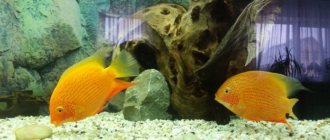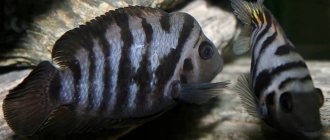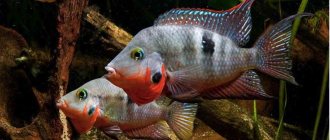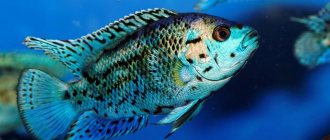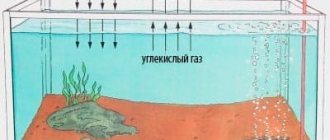Description
Distinctive features of disc cichlazoma:
- The body is in the shape of an irregular oval, hence the prefix - disk cichlazoma.
- The frontal line is concave.
- The back is rounded.
- The head is large.
- The upper and lower jaws are the same length.
- Adults in captivity reach 20–25 cm.
Diamond cichlazomas are capable of producing interspecific offspring. One of the results of such crossing was the brilliant balloon cichlizoma.
Appearance
The colors of diamond fish are one of the most attractive among aquarium fauna:
- The base color is dark brown.
- On top there is a “diamond” layer of shimmering spots in blue and green shades.
- On the sides there are poorly defined lines of dark tones in the direction from the back to the abdomen.
- A dotted line of round, dark spots stretches from the base of the caudal fin to the head.
Behavior
All cichlids are very active by temperament. Diamond disc cichlisomas have character and behavior characteristics that future owners need to take into account:
- Aggressiveness on a scale of 10 is around 6–7.
- They move a lot and plow up the bottom soil, regardless of its composition.
- They release many waste products.
- They feed so actively that food particles can be scattered throughout the tank.
- Requires a lot of space to move.
Some experienced owners claim that the fish recognize them when approaching the aquarium. If the cichlids do not like some element of the decoration, it is better to remove it from the container. It is in the nature of these fish to break everything that they do not like.
Lifespan
The average lifespan of cichlids is 7–10 years. Compliance with all the rules for the maintenance and care of these representatives of cichlases allows you to extend their life in captivity to a respectable 15–17 years.
Appearance
Diamond cichlazoma has a large, round, high body . In nature it grows up to 30 cm, in an aquarium its size does not exceed 15-20 cm. Young individuals have a pearl-gray color with bright white dots scattered over the entire surface of the body. There are 2 black spots in the center of the body and at the base of the caudal fin.
With age, the main color darkens - it becomes olive or gray with 4-6 dark spots. The largest in diameter are located in the center of the body and on the trunk of the caudal fin. "Diamond scattering" can be blue, turquoise and green. On the head, fins and front of the body, bright dots merge into wavy stripes.
Sexual dimorphism is noted - females are smaller in size and less brightly colored compared to males. During spawning the color changes. The front of the body becomes white and the back becomes black. A dark line may be located along the lateral surface of the body, barely visible in most individuals.
The large head has a concave forehead line. Dominant males may develop a fatty lump on their forehead. The mouth is terminal, which allows it to lift food from the substrate. A peculiarity of the oral apparatus of the diamond cichlazoma is the presence of pharyngeal teeth . They are located on the last arch of the gills, and they change every 50-100 days. There are also teeth on the jaws. Pharyngeal teeth are found in many species of cichlids and indicate the ancient origin of the family.
Unpaired fins have spine-like rays. There may be 15-18 of them in the dorsal fin, and 5-6 spines in the anal fin. With their help, fish protect themselves from larger predators. Currently, new hybrid forms have been obtained:
- brilliant red cichlasoma;
- Cichlazoma diamond balloon.
The fish is popular among aquarists who prefer large fish with interesting appearance and behavior.
Content
Fish are not particularly demanding in terms of care and living conditions; they are omnivores. They prefer animal food to a greater extent. You should not forget about plant feeding, otherwise the flora of the aquarium will suffer.
The second most important condition after volume is the correct division of the aquarium into zones. The presence of at least 3 types of landscape is important:
- Vegetable area.
- Free area for loosening the soil. If this point is not provided for in advance, the fish themselves will choose a place for excavation.
- An area with various types of cover. When choosing the decorations in which the fish will hide, consider the size of the adults.
If you plan to keep 2 pairs of cichlases, multiply all the indicated zones by 2. Otherwise, the fish themselves will begin to divide the aquarium in half.
Aquarium
We select the size of the aquarium for cichlases based on the following factors:
- Adults are large - 20–25 cm.
- They move a lot and actively.
- They always show territorial aggression.
The best tank parameters for keeping a pair of individuals:
- Volume 250–300 l.
- Length 1–1.3 m.
- A lid is required.
Water parameters
In their natural habitat, cichlids spend most of their time in the middle layer of the water area. Temperature changes from season to season are more than 20 degrees. Such living conditions have developed excellent adaptive qualities in cichlases. Diamond cichlazomas are not particularly picky about their contents.
Optimal environmental indicators:
- Temperature range 23–26 degrees.
- The content of hardness salts is within 15–20 degrees.
- Alkaline reaction 6.5–7.5 pH.
Plants
The habit of this type of aquarium fish to loosen the soil imposes certain requirements on plants:
- Strong root system.
- Thick stem.
- Hard leaves.
- Unpretentious to living conditions.
Even if the above conditions are met, it is recommended to plant vegetation in separate containers. This measure will protect the aquarium flora from damage and death. Decorative elements can be used to protect vegetation.
The best plants for cichlases:
- Echinodorus amazonica or major.
- Anubias nana.
- Bolbitis heteroclita.
- Lagenandra meebolda.
- Undulatus.
- Crinum calamistratum.
What plants do you use?
Priming
Diamond cichlazomas dig holes and build various walls and ramparts throughout their lives. Ichthyologists associate this behavior with the breeding cycle. But fish often engage in loosening and building during the periods between spawnings. Owners note the ability of cichlids to drag pebbles in their mouths; they simply roll larger stones along the bottom. When choosing soil, you need to take these features into account.
Suitable types:
- Pebbles of small and medium size.
- Various types of gravel.
- Granite or marble chips.
It is not recommended to use sand; due to constant loosening, the entire space of the aquarium will be enveloped in sandy dust.
Equipment
This is the main parameter when choosing equipment for cichlid breeding power. Fish lead a very active lifestyle, so they raise turbidity in the tank. In addition, cichlids have an accelerated metabolism and quite heavily pollute the water with excretory products.
For content you will need:
- A combined cleaning filter that combines mechanical and chemical functions. The chemical component is necessary to remove nitrates and ammonia. An excess of these substances causes ascites in cichlazoma.
- One of the options for biological filtration.
- Since the volume of water in the tank will be 100 liters or more, a powerful pump compressor will be needed.
- To reduce noise at night, you can install an additional piezo compressor.
- The thermostat will help maintain a stable climate within a closed ecosystem.
Lighting
Cichlazomas have few lighting requirements. But there are some subtleties. The backlight should be moderate. Excessive illumination is not needed; pearl cichlids spend most of their time in the bottom layers. Lack of light leads to a decrease in pigmentation and the fish change color to paler tones.
The best option is LED lights located in the tank lid. This type of lamp does not cause heating of the air space and the upper layers of water. Turn on the light for 10–12 hours.
Feeding
Diamond short-bodied cichlasoma is an omnivorous species. The diet in the natural environment is:
- Plants.
- Insect larvae.
- Small to medium sized clams.
- Shrimps.
- Fish up to 4–5 cm.
- Fry.
In captivity, the diet should be based on 30% plant food and 70% animal food. Tolerant of all types of feeding:
- Dry.
- Fresh.
- Frozen.
- Alive.
A plant-based diet includes:
- Duckweed.
- Salad leaves.
- Cabbage.
- Cereals.
Before feeding the plants, treat them with steam or boiling water.
Protein feed:
- Dry combined mixtures.
- Tubifex.
- Gammarus.
- Artemia.
- Bloodworm.
- Minced fish fillet.
- Squid and shrimp, preferably minced.
Don't forget, diamond cichlises are prone to obesity.
Share what you feed your cichlids.
Compatibility
Diamond cichlases cannot be classified as peace-loving fish. Behavior is aggressive at all stages of growth.
Cichlids of this species are hostile:
- To representatives of their own species.
- To individuals of both sexes of adjacent species.
- To most fish of other families.
- Fish smaller than the cichlid itself are considered food items.
- They eat shellfish and shrimp up to 3–5 cm in size.
At the age of 7–10 years, aggression only increases, especially towards young members of their own species. If cichlazomas are a pair, they get along calmly in the same aquarium. Two couples living together can lead to territorial clashes.
Despite their fighting nature, some types of aquarium fish are perfectly compatible with diamond cichlids:
- Cichlazoma zebra (black striped).
- Large kalasoma (black pacu).
- Ocellated astronotus.
- Biocelatum (Cichlazoma bee).
- Turquoise cichlid.
- Barbels (barbs).
- Masked cichlazoma (meeka).
- Catfish pterygoplicht (brocade).
- Pelmatochromis.
- Giant gourami.
- Dragon fish (arowana).
- Pseudotropheus.
- Apteronotus (black prince).
All of the neighbors listed above, except parrots, are impressive in size. When choosing who to add to the diamond cichlid, think about the size of the aquarium you will need for this.
Share your experience of keeping a diamond cichlid with other fish.
Compatibility with fish
For a community aquarium, cichlid will not be a good choice. The aquarium should be spacious for one cichlid or two. Much depends on the character of a particular individual, but there are often cases when a fish kills its neighbors.
Young cichlids suffer from older ones - they often lack food. Mature fish lose their timidity and become angry and dangerous.
If you want to keep this interesting fish with other species, then it should choose large specimens and preferably not cichlids as neighbors. Neighboring fish must be able to stand up for themselves. Among them are the following types:
- giant gourami;
- plecostomus;
- black pacu;
- brocade pterygoplichts.
Sometimes aquarists observe compatibility with black knives, since diamonds do not consider this type of aquatic inhabitants to be fish.
There are a number of fish with which they are compatible
Reproduction
In aquariums, diamondfish breed freely. No special effort is required on the part of the owner. Individuals become sexually mature at the age of 1–1.3 years.
Sex differences
Sexual differences are given for sexually mature individuals of the same age:
| Differences | Female | Male |
| Size | 6–8 | 10–12 cm |
| Forehead | Concave line. | Pronounced bulge. |
| Dorsal and anal plumage | Rounded ends. | The endings are elongated and have a pointed configuration. |
| Anal hole | Resembles a truncated cone | Pointed cone |
Spawning
Fish of this species are able to spawn all year round. The required break is 60 days.
To start reproduction you need:
- Place the pair in a spawning container with a volume of 100 liters.
- Raise the temperature to 27–28 degrees.
- Double the water changes.
- Increase the volume of fluid replaced to 33–35%.
- There is no need to change the hardness and pH parameters.
With frequent reproduction, the number of eggs in one litter gradually decreases by 5 times. After fertilization, the male may behave hostilely, so he is placed in a common tank. The period of ripening of caviar is up to 7 days. She is cared for entirely by the female.
Suitable for feeding fry:
- Finely chopped tubifex.
- Artemia.
- Cyclops larvae.
- Chopped roundworms.
- Living dust.
Breeding
Diamond cichlases exhibit sexual dimorphism: males are larger than females, their dorsal and anal fins are longer and more pointed, and their forehead is wide with a fatty growth. In addition, they are much more aggressive than females and can often pester other neighbors in the aquarium, especially during the spawning period and while raising offspring.
Sexual maturity occurs when the fish reach 8-10 cm. At this time, pairs begin to form in which the fish stay together throughout their lives. Since it is impossible to determine the sex of young fish, you can take a flock of cichlases from 6-8 individuals, allowing them to choose a suitable partner.
For breeding, it is worth using a separate spawning tank, since during reproduction, diamond cichlids become aggressive and can harm neighbors.
The stimulus for reproduction is an increase in high-protein feed in the diet, an increase in temperature by a couple of degrees and more frequent water changes. The male selects a substrate - a flat, smooth object, thoroughly cleans it and begins spawning. As soon as the preparations are completed, courtship will begin, which from the outside may seem rude. Fish can “fight” with their tails, or aggressively “kiss” by grabbing each other’s lips.
After the mating dances, spawning begins. The female lays a batch of eggs, which are immediately fertilized by the male. The clutch is guarded by both parents; they fan it with their fins, keep it clean and remove dead eggs. Sometimes during this period the male can be too aggressive even towards the female, so he must be removed from the aquarium if he becomes overly active.
Incubation of eggs lasts 2-3 days, after which the larvae hatch. For the first 4-5 days they feed on the contents of the yolk sac and move little. After it resolves, the fry begin to swim in search of food. During this period you need to start feeding them:
- “living dust” (ciliate culture);
- microworm;
- decapsulated Artemia eggs and nauplii.
Feeding should be organized 2-3 times a day in small portions.
While the fry are growing, the parents carefully guard them, protecting them from danger, raising mud from the bottom and biting into large pieces of food, helping them to eat. If one baby strays from the group, the adult fish catches it in its mouth and brings it back. But as soon as the juveniles reach 1 cm in length, they should be separated from the breeders, since by this moment the latter have lost their parental instinct and can feast on their own offspring.
Diseases
Like all cichlids, the diamond cichlid has no congenital prerequisites for diseases. Various pathologies arise only when the correct housing and feeding conditions are not observed.
To exclude diseases, you need to follow several rules:
- Water replacement should occur strictly every 6-7 days.
- It is recommended to buy food in specialized stores.
- You cannot feed cichlid larvae collected from nature.
- Pieces of vegetables must be treated with boiling water or steam before feeding.
- If a fish develops symptoms of any disease, it is urgently necessary to isolate it from other inhabitants. After this, treatment of the tank, equipment, soil and decorations with a solution of 3% hydrogen peroxide is required.
- If the soil is not purchased, it must first be treated with chlorhexidine or chloramine, and then calcined in the oven at a temperature of 180 degrees.
- Make sure that the requirements for the composition and temperature of the water remain within normal limits.
- Mandatory quarantine for new residents for 12–14 days.
By following these rules, you will keep your fish alive and healthy.
Diseases often found in cichlids:
Ascites (dropsy)
| Symptoms, changes in behavior | Treatment | Causes | ||
| Feed additive | Adding to the Aquarium | Baths | ||
| Loss of appetite, photophobia, sharp decrease in activity. The body swells, the eyes bulge. | Kanamycin 0.5 g per 0.5 kg of feed. | Isoniazid 0.3 g per 70 l. sera baktopur 1 ml per 20 l. Sulfamonomethoxine 0.25 g per 250 l. Erythromycin 1 tablet 0.25 g per 250 l. | Levomycetin 0.1 g per 1 liter, for 12 hours. Aqueous solution of methylene blue 50 ml per 0.5 liter, for 6 hours. | Water pollution, low temperature conditions, drafts, increased content of ammonia salts and nitrates, contaminated live and plant food, introduction of infected individuals. |
Ichthyophthiriasis (semolina)
| Symptoms, changes in behavior | Treatment | Factors of infection | |
| Adding to the Aquarium | Baths | ||
| Bumpy white rashes all over the body. The fish try to scratch themselves on the ground, press their fins to their body, and tremble. | Anti-steam 1 ml per 50 l. Malachite green oxalate 1% solution. 1 ml per 100 l. | Anti-steam 1 ml per 10 l, for 3 hours. Malachite green oxalate 1% solution. 1 ml per 10 l, for 35 min. | Feeding infected ciliates. Failure to comply with quarantine measures upon arrival. |
With successful treatment, immunity is developed.
Dactylogyrosis
| Symptoms, changes in behavior | Treatment | The culprits of the disease | |
| Adding to the Aquarium | Baths | ||
| The color of the gills is pale pink, mucous discharge. Refusal of food. Hard breath. The fish stay near the compressor | Bicillin-5 500 IU per 10 l. In a separate container - copper sulfate 0.15 g per 100 l. | Masotene 1 g per 2 l. A sequence of three baths: a solution of copper sulfate, basic violet, Bicillin-5. | The parasite is introduced into the reservoir with food, soil or feed from natural bodies of water. No quarantine. |
PICTURE OF THE DISEASE
Lepidorthosis
| Symptoms, changes in behavior | Treatment | Sources | |
| Adding to the Aquarium | Baths | ||
| Partial or complete loss of scales. Behavior doesn't change. | Bicillin-5 500 IU per 10 l. Biomycin 0.15 g per 10 l. Streptocide 0.30 g per 20 l. | Basic purple 1 g per 10 l. | Not purchased plants, food and soil. Accommodation without quarantine. |
Plistophorosis
| Symptoms, changes in behavior | Medicines | Etiology |
| The color loses its brightness and large white spots appear. Lack of appetite, dystrophy. Increased activity, fish bump into obstacles. | Stop-coccid, Fumagelin, Nemazol, Sodium monesin. | Introducing infected individuals into the aquarium. |
The disease is considered incurable.
Tell me, what other diseases are diamond cichlisomas susceptible to?
Diseases and their prevention
Diamond cichlazomas do not have an innate predisposition to certain diseases. Therefore, all problems with their health come from improper care and violation of maintenance standards. The most common diseases:
- Ascites (hydrosis). The fish loses its appetite, becomes apathetic, and avoids light. There is bulging eyes.
- Ichthyophthyriosis. It is expressed by the appearance of a large number of white dots on the body.
- Dactylogyrosis. The gills of a sick individual become covered with mucus and change color.
- Lepidorthosis. There is swelling of the scales and the formation of bubbles under it.
- Plistophorosis. The fish becomes hyperactive, nervously moves its head and has difficulty finding its way around the aquarium.
Most diseases can be cured in the first stages with the help of ordinary baths with medicines.
To prevent the development of many diseases, it is enough to follow simple but important preventive measures:
- Change the water in the aquarium at least once a week.
- If a sick individual is found, quarantine it in a separate container, and treat all decorations in a common reservoir with chlorhexidine or hydrogen peroxide.
- Purchase soil and feed only in special stores, and do not collect it yourself near natural reservoirs.
- Maintain all required water parameters (temperature, hardness, acidity) within normal limits.
Diamond cichlases certainly cannot be called easy to keep. They are capricious and unfriendly. However, by showing attentiveness, patience and care, you can turn these wayward beauties into a real decoration of the aquarium.
